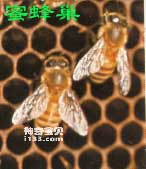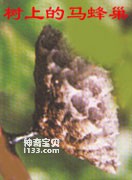Insects also have many architects to build "houses" for themselves, especially bees and wasps of the order Hymenoptera, which are simply the most brilliant architects. Different types of bees build different houses. The strange shape and ingenious structure of the bee's hive are truly ingenious, and have aroused the strong interest of scientists very early on. As early as the beginning of the 18th century, French scientist Maral conducted careful observation and research on beehives. He compared each cell on the hive and found that the holes and bottom of each cell were hexagonal. If the bottom of each cell was divided into three rhombus sections, the degrees of each acute angle and each obtuse angle would be equal ( The acute angle is about 72° and the obtuse angle is about 109°). The mouth of the hive is all facing downward or to one side. Building the hive into a hexagonal shape can not only save materials, but also rationally utilize space and increase capacity.

1. Beehive
So how is the hive built? The work of building the hive of bees is entirely undertaken by worker bees. They first suck nectar, and then the two worker bees use their front feet to grasp the object above them tightly, and extend their hind legs for the two worker bees below to grab them. They are connected to each other in this way, forming two bee chains. When the required length is reached, the last bee chain in each chain uses the swing of its midfoot and the vibration of its wings to merge the original two bee chains into one chain. After about a day's rest, the honey in the worker bee's body is absorbed and decomposed into beeswax, which then secretes a thin layer of wax flakes through the wax plate secretion gland at the end of the abdomen. At this time, they separated for the next step of nesting. The worker bees first use the hairs on their feet to brush off the secreted wax flakes, put them into their mouths and chew them into multiple small plates, and then pass these wax plates to the worker bees waiting to build a nest on the box board. They take the wax slab with their mouths and spread it evenly on the top plate as the basis of the hive. Other worker bees brought wax plates to gradually raise the base of the nest. A wax pillar hung down from the top board, and another worker bee made a hexagonal hole in the middle of the wax pillar. After careful carving, the first hexagonal hive was built. Maybe this worker bee is the chief architect? Now that the basic shape is in place, all the other worker bees are starting to work hard. They constructed in an orderly manner, building hexagonal single-room solitary hives that were connected to each other, and finally formed a beautiful and unique hive.

Wasp nests are often built on tree branches, under eaves, in tree holes or inside houses. There are also types built underground. Wasps belong to the order Hymenoptera, Vespididae, and undergo complete metamorphosis. This class includes social species and solitary species. Social wasps generally have three levels, namely queen, worker bees and drones. The general group size is not large. The queen begins taking wood fibers in the spring, chewing them into pulp, and uses them to build her nest. After it selects a nesting site, it first builds a short cylindrical base on the branches or wooden rafters of the eaves, and then gradually expands it on the column base to build an approximately half-moon-shaped hanging bell nest. The size of the nest varies, the largest is that of the giant wasp, which can reach 66 cm in diameter. The bumblebee's nest is oval in shape (25 cm x 18 cm) and is built in a wall gap. After the queen has finished building the nest, she lays one fertilized egg in each hive. After the legless larvae hatch, they are fed captured insects, honey and other substances every day. After the growth and development of the larvae is completed, the adult bee seals the hive opening with paper pulp and allows it to pupate inside. The pupa emerges as an adult and emerges by biting through the sealing paper. After worker bees emerge in autumn, they mate when sexual insects appear. In the nest group, only the young queen is left to survive the winter, and a new nest is rebuilt in the following spring. The queen no longer lays eggs and raises children in the old nest. Instead, she builds a new house on top of the old nest. In a year, she can build a dozen-story "building" hanging upside down on a cliff or a branch. If the building materials contain too much water and are not strong enough, they will flap their wings to dry out the nest. The bell-like "buildings" of wasps and hornets do not take up any land area, and can be high up to avoid human harassment and natural enemies, providing new ideas for mankind in architecture.



2. Insect galls
Insect galls are deformed structures that grow when plant tissue is stimulated by insect secretions and accelerates cell division. They come in a variety of shapes, usually cystic, spherical or cylindrical. This is also a house built by insects. The larvae feed inside and pupate throughout their lives. After emerging into adults, they bite through the insect gall and come out. They then find plants to lay their eggs. The larvae hatch and feed and then re-form the insect gall. Aphids, scale insects, weevils, sawflies, gall midges, gall moths, etc. can all cause galls on plants. The gallnut produced in my country is caused by the gall aphid and contains tannic acid, which can be used in dyes, chemicals, tanning, traditional Chinese medicine, etc.



3. Termite Tower
A termite tower is a type of ant mound, in which soil-dwelling termites build nests in the soil below the ground, and the nests are higher than the ground to form a tower shape. Anthills vary in size, some are taller than a person. This really takes a lot of hard work to build.

4. Soil honeycomb
The honeycomb is very interesting. It is made by bumblebees using the earthen cells of scarab beetle larvae. Bumble bee larvae are ectoparasites of scarab beetle larvae. The female adult of the bumble bee often burrows into the soil to look for scarab larvae. After finding it, it injects venom with its pincers to anesthetize it, then lays eggs on it and seals them in the earth chamber. The larvae can feed after hatching, and after completing their development into adults, they fly out to find new hosts to lay eggs.
animal tags:
We created this article in conjunction with AI technology, then made sure it was fact-checked and edited by a Animals Top editor.